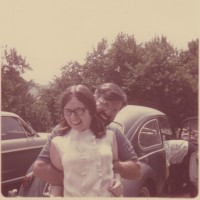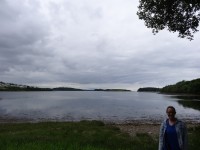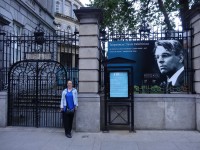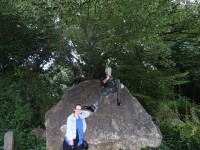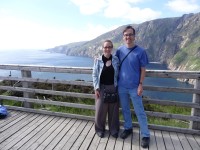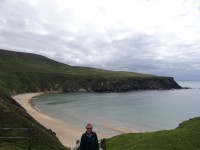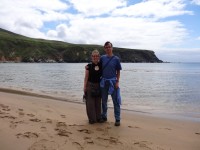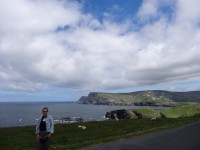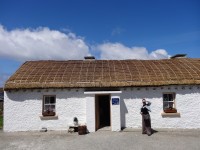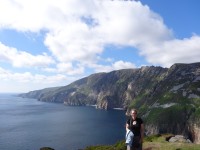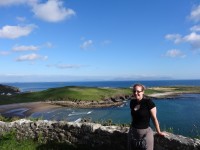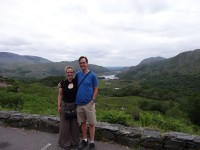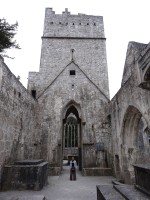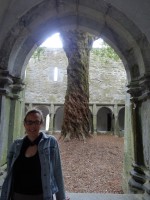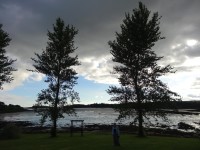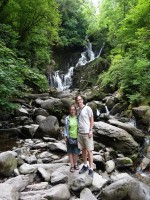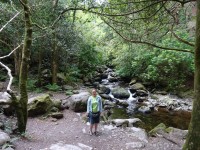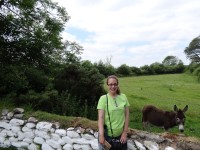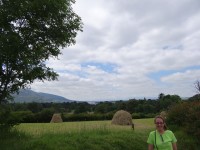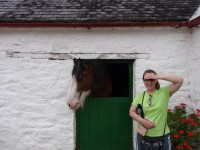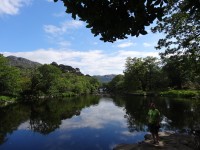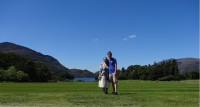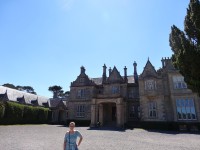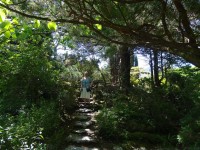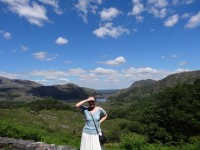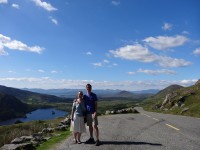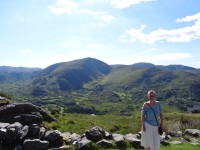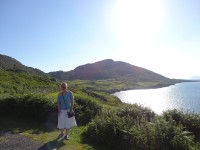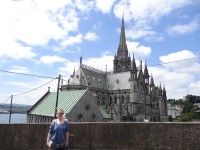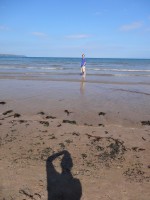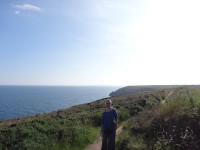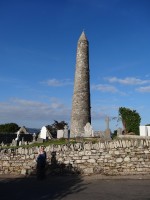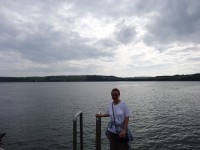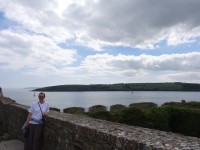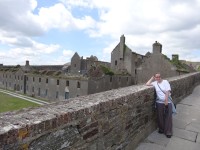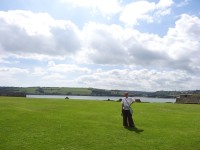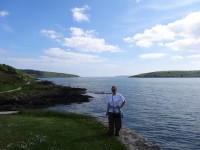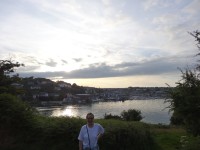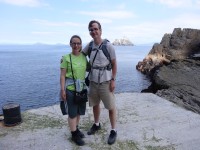 Life has many choices, and our hostel has helped out by removing one of them – the pesky shower controls. These have been replaced by a single “on” button that shoots out as-hot-as-you-can-stand-it water, for about forty-five seconds at a time, after which you can hit the button again. It certainly saves water, as my shower lasted all of about three minutes.
Life has many choices, and our hostel has helped out by removing one of them – the pesky shower controls. These have been replaced by a single “on” button that shoots out as-hot-as-you-can-stand-it water, for about forty-five seconds at a time, after which you can hit the button again. It certainly saves water, as my shower lasted all of about three minutes.
Mer had us up early and on the road by about 7:15 this morning. We headed west and north out onto the Ring of Kerry. It was early enough that we did not meet much traffic, and none of the later-in-the-day tour buses. We turned off the “main” road (if such a thing exists in Ireland), and we turned onto an often-one-lane road where the speed limit still fluctuated between 45 and 60 mph. Driving in Ireland often feels like a driving video game, but with sheep in the road sometimes.
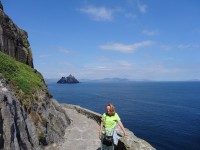 We drove far out on to the Iveragh Peninsula (which is where people do the famous Ring of Kerry loop drive), on to the Ring of Skellig. This path is closed to tour buses, as the roads are far too narrow to accommodate them. If you meet an oncoming car, you have to pull over as far as you can into the bushes, and slow to a crawl or a stop until the other car gets past. It is interesting.
We drove far out on to the Iveragh Peninsula (which is where people do the famous Ring of Kerry loop drive), on to the Ring of Skellig. This path is closed to tour buses, as the roads are far too narrow to accommodate them. If you meet an oncoming car, you have to pull over as far as you can into the bushes, and slow to a crawl or a stop until the other car gets past. It is interesting.
Mer directed us over an excitingly narrow pass that lacked drop-offs, but made up for it in blind, one-lane, hairpin turns. The views all along the drive were tremendous — fields, mountains, ocean, cute towns. After about two hours, we arrived at our destination, Portmagee, where we were supposed to catch a boat out to Skellig Michael, a jut of rock seven miles out in the ocean that housed a monastery from about 600 to about 1100. Sadly, one of the two boats going out was broken, so they asked us to come back at 2:00 (we were scheduled for 9:30). There was nothing we could do about it, so we agreed, but it meant back-tracking over the same road on which we had come in, to go back one hour to get to another sight Mer wanted to see.
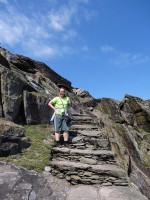 But first, food. My breakfast of a granola bar and one roll had worn thin, so I insisted on getting some food. Mer knows that one of the best ways to keep me happy is to keep me fed, so she agreed. We overshot our destination by about a mile so I could go to a market and buy two chicken sandwiches and two candy bars for our very early lunch. We ate them on a covered patio overlooking the ocean.
But first, food. My breakfast of a granola bar and one roll had worn thin, so I insisted on getting some food. Mer knows that one of the best ways to keep me happy is to keep me fed, so she agreed. We overshot our destination by about a mile so I could go to a market and buy two chicken sandwiches and two candy bars for our very early lunch. We ate them on a covered patio overlooking the ocean.
After lunch, we headed down another horse-track-width road to Derrynane House, the home of Daniel O’Connell. Daniel O’Connell is known in Ireland as “The Liberator,” as he fought for the rights of Irish Catholics during the 1800s, using non-violence, through law and politics. His home is fairly simple, although a grateful Catholic community built him a chapel next to his house. The grounds are amazing and fairly wild, and are now a national park. To tour the house costs a little, but it was free on our Heritage Cards. The tour took about a half hour, which was followed by a twenty-minute film on the life of O’Connell. It was interesting. After the tour and film, we took a quick glance at the chapel (simple, but nice) and the fancy carriage O’Connell’s supporters gave him when he was released from a several-month prison term.
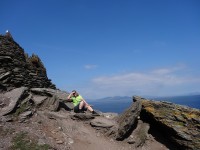 By then, we had to drive the hour back to the boat for the tour. Since Skellig Michael is seven miles out in the ocean, it took about an hour to get out there. The trip was lovely, with calm seas, lots of sun, and great views of all three peninsulas (Beara, Kerry, and Dingle).
By then, we had to drive the hour back to the boat for the tour. Since Skellig Michael is seven miles out in the ocean, it took about an hour to get out there. The trip was lovely, with calm seas, lots of sun, and great views of all three peninsulas (Beara, Kerry, and Dingle).
Next to Skellig Michael is Little Skellig, a bird sanctuary. It roosts about sixty thousand gannets, which are large white sea birds. As you approach the island, it looks as if it is covered in snow.
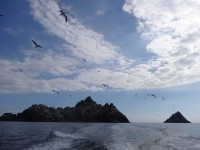 Skellig Michael looms over the sea. It is about seven hundred feet high, with no vegetation other than grasses. The island seems to come straight out of the sea. We pulled in to a dock in a crack in the rock, and filed off the boat. We were there to hike up six hundred very steep steps that lacked any guard rails, and usually had a nasty fall off one side. Interesting. The prize was a collection of beehive huts and a few other primitive buildings at the very top.
Skellig Michael looms over the sea. It is about seven hundred feet high, with no vegetation other than grasses. The island seems to come straight out of the sea. We pulled in to a dock in a crack in the rock, and filed off the boat. We were there to hike up six hundred very steep steps that lacked any guard rails, and usually had a nasty fall off one side. Interesting. The prize was a collection of beehive huts and a few other primitive buildings at the very top.
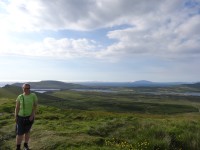 I was worried my fear of heights would kick in, and Mer was worried she might trip. We made it about halfway up when Mer’s fear of tripping really began to worry her. A guide who lives on the island was coming down, and she told us the steps got steeper at the top, and there was a ledge that needed to be crossed. That worried me, so after talking things over with the guide, we all headed down, with the help of another guide. Mer was disappointed, but after fifteen or twenty minutes, we went back up the steps a little ways to a viewing point and sat there for ten minutes to enjoy the view (and the rather fun noise puffin birds make, which sounds like small chainsaws).
I was worried my fear of heights would kick in, and Mer was worried she might trip. We made it about halfway up when Mer’s fear of tripping really began to worry her. A guide who lives on the island was coming down, and she told us the steps got steeper at the top, and there was a ledge that needed to be crossed. That worried me, so after talking things over with the guide, we all headed down, with the help of another guide. Mer was disappointed, but after fifteen or twenty minutes, we went back up the steps a little ways to a viewing point and sat there for ten minutes to enjoy the view (and the rather fun noise puffin birds make, which sounds like small chainsaws).
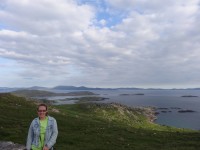 Back on the boat, the captain took us halfway around the island to show us the lighthouses. Along the way, we saw two seals sunning themselves. We then were treated to a close-up view of Little Skellig and its sixty thousand inhabitants. We were not pooped on, but I got some secondary splatter on a near-miss.
Back on the boat, the captain took us halfway around the island to show us the lighthouses. Along the way, we saw two seals sunning themselves. We then were treated to a close-up view of Little Skellig and its sixty thousand inhabitants. We were not pooped on, but I got some secondary splatter on a near-miss.
The seas on the trip back were rougher, and we got wet from spray a few times. This reinforced to us that neither Mer nor I am fit to be a sailor. It was fun on one trip, but I think that would get old pretty quickly.
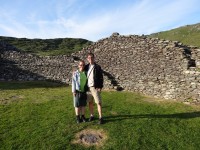 After the hour back on the boat, we still had the two-hour car drive, and it was already 6:30. So, we headed back over the same stretch of road for the fourth time. About seventy-five minutes into the drive, we did take a short detour to go see a well-preserved two-thousand-year-old ring fort that was made by piling stones on one another (no mortar). We ran into a charming older Irish couple in this remote fort, and chatted with them briefly. The fort was being besieged by a herd of cows and sheep, but they must have a treaty in place, because they let us pass.
After the hour back on the boat, we still had the two-hour car drive, and it was already 6:30. So, we headed back over the same stretch of road for the fourth time. About seventy-five minutes into the drive, we did take a short detour to go see a well-preserved two-thousand-year-old ring fort that was made by piling stones on one another (no mortar). We ran into a charming older Irish couple in this remote fort, and chatted with them briefly. The fort was being besieged by a herd of cows and sheep, but they must have a treaty in place, because they let us pass.
We finally got back to Kenmare a little after 9:00, and we found a pub/restaurant still serving food around 9:30. That was happy, because shortly thereafter, the live music started. We tried a bunch of times to find live music in Kinsale, and only found it by accident at the Tap Tavern. In Kenmare, we have heard strains of music coming out of multiple places on both nights we have been here. Our musician played guitar and sang, and we got to hear him for over a half hour before we were done eating. It was very pleasant.
After supper, we found that the local ice cream shop was still open, so we tried it. My cookies and cream was only okay, but Mer got some unusual flavors that she liked (a banana-toffee mixture and a candy ice cream). Oh – if an Irish ice cream place puts fudge pieces on your ice cream, it means soft caramels. Just for your information.
We got back to the hostel at dark – the first time that has happened on this vacation, since evening comes so late here. Here is hoping things go a little more according to Mer’s plan tomorrow.
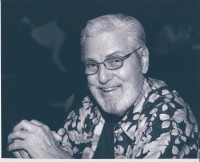 Meredith’s dad, Dale, did pass away on Sunday, June 22nd. We were still en route to Dublin to catch a plane home. We got home to our house around 11:45 Monday night. That was not a terrible thing – we did not have to see Dale sick in his hospital bed. Aunt Mary and Carlene (Meredith’s mom) were there, and they sang hymns as Dale’s breathing slowed and then stopped. It sounded very peaceful, and we got home soon enough to start to help with the planning for calling hours and a memorial service. Dale will be laid to rest in Carlene’s family plot in Maine, so we will be up there as well.
Meredith’s dad, Dale, did pass away on Sunday, June 22nd. We were still en route to Dublin to catch a plane home. We got home to our house around 11:45 Monday night. That was not a terrible thing – we did not have to see Dale sick in his hospital bed. Aunt Mary and Carlene (Meredith’s mom) were there, and they sang hymns as Dale’s breathing slowed and then stopped. It sounded very peaceful, and we got home soon enough to start to help with the planning for calling hours and a memorial service. Dale will be laid to rest in Carlene’s family plot in Maine, so we will be up there as well.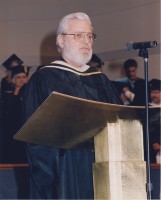 Dale Barton King, age 84, made the final steps of his earthly pilgrimage on Sunday, June 22, 2014. Born to Frank and Mary King in Flint, Mich., he is survived by his brother, Frank King; his sister, Mary King; his wife, Carlene Wooster King, and their daughter, Meredith King Riordan and her husband, Matt.
Dale Barton King, age 84, made the final steps of his earthly pilgrimage on Sunday, June 22, 2014. Born to Frank and Mary King in Flint, Mich., he is survived by his brother, Frank King; his sister, Mary King; his wife, Carlene Wooster King, and their daughter, Meredith King Riordan and her husband, Matt.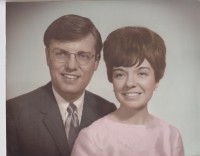 know God better and to communicate this knowledge to those around him. During the 70s and 80s, he served as a part-time pastor at New Baltimore Community Church in New Baltimore, Ohio, and was most recently a grateful and enthusiastic member of St. Paul’s Presbyterian Church in Orlando, Fla.. Those who had the privilege of knowing Dale will miss his spiritual insights, his sense of humor, and his annual Christmas letters that sent most readers running to the dictionary multiple times.
know God better and to communicate this knowledge to those around him. During the 70s and 80s, he served as a part-time pastor at New Baltimore Community Church in New Baltimore, Ohio, and was most recently a grateful and enthusiastic member of St. Paul’s Presbyterian Church in Orlando, Fla.. Those who had the privilege of knowing Dale will miss his spiritual insights, his sense of humor, and his annual Christmas letters that sent most readers running to the dictionary multiple times.